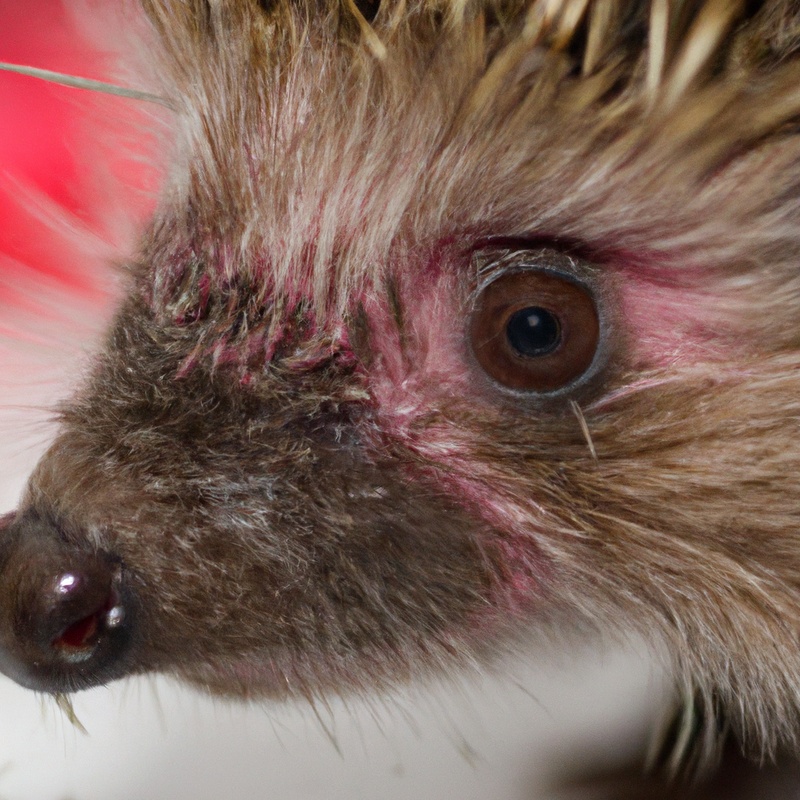How Do Hedgehogs Hibernate?
Key Takeaways:
- Hedgehogs hibernate to survive the harsh winter months.
- During hibernation, a hedgehog’s heart rate and metabolism significantly decrease.
- Hedgehogs prepare for hibernation by building nests and storing food.
- Hibernation helps hedgehogs conserve energy and maintain their body temperature.
Are you curious about how hedgehogs survive the harsh winter months? Well, you’re in luck! In this article, we’ll dive into the fascinating world of hedgehog hibernation.
From their physical changes to their behavior patterns, we’ll uncover the secrets behind their winter survival strategies.
But it’s not all cuddly and cute – we’ll also address the risks and threats they face during hibernation and how we can help them stay safe. So, grab a cozy blanket and join us on this journey to discover how hedgehogs hibernate and what we can do to support them.
Let’s dive in!
| Topic: | How do hedgehogs hibernate? |
| Question: | What is the hibernation process of hedgehogs? |
| Answer: | Hedgehogs hibernate during the winter months to conserve energy and survive harsh conditions. |
What is Hibernation?
Hibernation is a state of dormancy in which animals enter during the winter months to conserve energy.
It allows them to survive when food and resources are scarce.
Definition of Hibernation
Hibernation is a natural state of dormancy that some animals enter during the winter months.
During hibernation, an animal’s metabolic rate slows down significantly, allowing it to conserve energy.
The body temperature also drops, and the animal enters a state of reduced activity and awareness.
This helps the animal survive when food and resources are scarce.
Hibernation is a remarkable adaptation that allows certain species to endure harsh conditions and emerge in good health when the season changes.

Purpose and Benefits of Hibernation
Hibernation serves the purpose of conserving energy during the winter months when food is scarce.
Hedgehogs, like many other animals, enter hibernation to survive harsh conditions.
This state allows them to lower their body temperature and metabolic rate, reducing the need for food and water.
Hibernation also provides several benefits, such as protecting hedgehogs from predators and reducing their risk of dehydration.
It helps them preserve their fat reserves and survive until spring arrives when food becomes readily available again.

Hedgehog Species that Hibernate
Some hedgehog species that hibernate include the European Hedgehog, North African Hedgehog, and Southern White-Breasted Hedgehog.
European Hedgehog (Erinaceus europaeus)
The European Hedgehog, scientifically known as Erinaceus europaeus, is a species of hedgehog that hibernates during the winter months. During hibernation, they enter a state of dormancy where their metabolism slows down, body temperature drops, and they conserve energy.
They build nests, called hibernacula, to keep warm and safe during this period.
Hedgehogs prepare for hibernation by feasting on insects and other food sources to store fat reserves. Once winter arrives, they find a suitable hibernation spot and settle in until spring.
Hibernation is a vital survival strategy for hedgehogs to endure the cold and food-scarce winter months.
North African Hedgehog (Atelerix algirus)
The North African Hedgehog, scientifically known as Atelerix algirus, is a species of hedgehog that is found in North Africa. One interesting thing about this hedgehog is its ability to hibernate.
During hibernation, the North African Hedgehog goes into a state of deep sleep to conserve energy.
This allows them to survive in harsh winter conditions when food is scarce. They lower their body temperature and slow down their metabolism.
This adaptation helps them to conserve energy and survive until spring arrives.
So, hibernation is an important survival strategy for the North African Hedgehog.
Southern White-Breasted Hedgehog (Erinaceus concolor)
The Southern White-Breasted Hedgehog, scientifically known as Erinaceus concolor, is a unique species that hibernates during the winter months. Hibernation is an essential survival mechanism for these hedgehogs, helping them conserve energy and survive in harsh conditions.
During hibernation, their body temperature drops, their heart rate slows down, and they enter a state of deep sleep.
This adaptation allows them to endure long periods of scarcity and cold temperatures. To prepare for hibernation, Southern White-Breasted Hedgehogs accumulate fat reserves by feeding heavily in the autumn.
Once winter arrives, they find a cozy and safe spot to curl up and conserve energy until springtime.
Preparing for Hibernation
Before entering hibernation, hedgehogs engage in essential tasks such as seasonal changes and triggers, nest building and shelter selection, and accumulating fat reserves.
Seasonal Changes and Triggers
Seasonal changes and triggers play a crucial role in the hibernation process of hedgehogs.
As temperatures drop and daylight hours decrease, these changes signal hedgehogs to prepare for hibernation.
The decreasing temperatures and reduced food availability prompt hedgehogs to seek out a safe and sheltered spot for their winter slumber.
Additionally, changes in hormone levels within their bodies also play a significant role in triggering hibernation.
Hedgehogs rely on these cues from their environment to enter a state of deep sleep and conserve energy until the conditions improve in spring.
Nest Building and Shelter Selection
Nest building and shelter selection are essential for hedgehogs before hibernation.
They create nests using leaves, grass, and other materials to keep warm during the winter.
Hedgehogs look for a safe and cozy spot to build their nests, like under bushes, in piles of leaves, or in log piles.
A well-insulated nest and a secure shelter are important for their survival during hibernation.
So, ensure you provide suitable materials and a safe hiding place for hedgehogs in your garden.
Accumulating Fat Reserves
Accumulating fat reserves is crucial for hedgehogs before hibernation. They need to eat plenty of food to build up their fat stores.
This helps them survive the long winter months when food is scarce.
Hedgehogs will forage for insects, slugs, and worms to consume. They will also eat fruits and berries.
By consuming a high-calorie diet, hedgehogs can ensure they have enough energy to sustain them while they are in hibernation.
It is important to remember that a hedgehog’s ability to accumulate enough fat reserves can determine its chances of surviving the winter.
Physical Changes during Hedgehog Hibernation
During hibernation, hedgehogs experience a drop in body temperature, decreased heart rate and metabolism, and limited movement and muscle activity.
Body Temperature Drop
During hibernation, hedgehogs experience a dramatic drop in their body temperature.
This drop is crucial for their survival during the winter months.
Hedgehogs can lower their body temperature to match the temperature of their surroundings, which helps conserve energy.
Their heart rate and breathing also decrease significantly.
This allows hedgehogs to enter a state of torpor, where their body functions slow down.
This lowering of body temperature is a natural adaptation that helps hedgehogs conserve energy and survive through the harsh winter.
Decreased Heart Rate and Metabolism
During hibernation, hedgehogs experience a significant decrease in their heart rate and metabolism.
This decrease in heart rate helps them conserve energy and slows down their overall bodily functions.
Their metabolism also slows down, allowing them to minimize energy expenditure and survive with limited food resources.
These physiological changes are crucial for hedgehogs to survive the long winter months when food is scarce.
By reducing their heart rate and metabolism, hedgehogs can conserve energy and maintain their body temperature at a lower level.
Limited Movement and Muscle Activity
During hibernation, hedgehogs experience limited movement and muscle activity. They enter a state of torpor, where their metabolic rate slows down significantly.
This reduction in metabolic activity helps conserve energy, but it also means that their muscles become less active.
Hedgehogs may curl up tightly to further conserve heat and minimize movement. This limited movement and muscle activity allow hedgehogs to conserve energy and survive through the winter months when food is scarce.
Hedgehog Behavior during Hibernation
During hibernation, hedgehogs enter a deep sleep and their behavior significantly changes.
Timeframe and Duration
During hibernation, hedgehogs typically enter this state in late autumn or early winter, usually between November and December. They remain in hibernation for several months, typically until March or April, when temperatures start to rise.
The duration of their hibernation period can vary depending on factors such as temperature and food availability.
Hedgehogs can hibernate for as little as a few weeks or as long as several months.
Sleep Patterns and Behavior in Hibernacula
During hibernation, hedgehogs experience a change in their sleep patterns and behavior.
They enter a state of torpor, where their metabolic rate slows down significantly, and their body temperature drops.
Hedgehogs curl up into a tight ball and find a safe place, like a hibernaculum, to sleep in.
They may sleep for long periods, waking up occasionally to move or adjust their position.
This allows them to conserve energy and survive the winter months when food is scarce.
Hedgehogs are remarkable animals that have adapted unique sleep patterns and behaviors during hibernation to ensure their survival.
Arousals from Torpor
During hibernation, hedgehogs experience periods of arousal from torpor.
These arousals occur every few days and can last for several hours.
Hedgehogs wake up, raise their body temperature, and may even leave their hibernation nests to search for food and water before returning to torpor.
These arousals are crucial for hedgehogs to replenish their energy reserves and alleviate physiological stress.
Arousals from torpor allow hedgehogs to survive the winter by balancing energy conservation with necessary activities.
Hedgehog Hibernation and Survival Strategies
Hedgehogs have developed unique survival strategies for hibernation to withstand the challenges of winter.
Adaptations for Winter Survival
Hedgehogs have several adaptations that help them survive during winter. One of the main adaptations is hibernation.
Hedgehogs go into a deep sleep during extremely cold weather to conserve energy and maintain their body temperature.
They find a sheltered spot, such as a burrow or a pile of leaves, and curl up tightly to reduce heat loss. Additionally, hedgehogs build up a layer of fat before winter, which serves as insulation and a source of energy during hibernation.
They also have thick fur that helps trap heat and keep them warm.
These adaptations allow hedgehogs to endure the harsh winter conditions and emerge healthy in the spring.
Overcoming Challenges while Hibernating
Hibernation is a challenging time for hedgehogs, but they have some clever strategies to overcome these challenges. One challenge they face is maintaining their body temperature.
Hedgehogs lower their metabolic rate and curl up tightly to conserve heat.
Another challenge is finding enough food before hibernation. They eat large amounts of food to build up fat reserves.
Lastly, hedgehogs need to find a safe place to hibernate.
They search for a sheltered spot, such as under piles of leaves or in dens, to protect themselves from predators. Hedgehogs have developed these survival strategies to ensure their successful hibernation each year.
Monitoring Hedgehog Hibernation
To ensure the well-being of hedgehogs during hibernation, it is important to monitor their hibernation patterns and behavior.
Signs and Indications of Hibernation
During hibernation, hedgehogs exhibit several signs and indications. These include a drop in body temperature, reduced heart rate, and slowed breathing.
Hedgehogs also build nests or find sheltered areas to sleep in.
They become less active and may not move or eat for prolonged periods. If you notice a hedgehog curled up tightly, with little to no response when approached or touched, it is likely in hibernation.
Additionally, their spines will stick out more than usual, providing extra protection during this dormant period.
Importance of Monitoring Hedgehogs during Hibernation
Monitoring hedgehogs during hibernation is important because it allows us to track their health and population trends.
By regularly checking on them, we can ensure their well-being and detect any issues that may arise.
This information is valuable for conservation efforts and understanding their behavior.
Additionally, monitoring can help identify habitats that need protection and aid in the development of effective conservation strategies.
Taking care of these adorable creatures during their hibernation is crucial for their survival.
Risks and Threats to Hedgehogs during Hibernation
During hibernation, hedgehogs face risks and threats such as human interference, impacts of climate change, and predators.
Human Interference and Disturbance
Human interference and disturbance can have detrimental effects on hedgehogs during hibernation.
Some common examples include:
- Disturbing their hibernation spots: Avoid disturbing areas where hedgehogs may be hibernating, such as log piles, compost heaps, or under sheds.
- Providing artificial warmth: Resist the temptation to provide artificial warmth to hibernating hedgehogs, as this can disrupt their natural hibernation cycle.
- Feeding them during hibernation: Hedgehogs do not require food during hibernation, so avoid leaving out food for them. This can disturb their hibernation and prevent their bodies from entering the necessary state of low metabolic activity.
- Handling hibernating hedgehogs: It is important to avoid handling hibernating hedgehogs, as this can cause them to wake prematurely and deplete their energy reserves, making it harder for them to survive the winter.
By being mindful of these risks and avoiding unnecessary disturbance, we can help hedgehogs successfully hibernate and ensure their survival during the winter months.
Impact of Climate Change on Hibernation Cycles
Climate change has a significant impact on the hibernation cycles of hedgehogs.
With rising temperatures and erratic weather patterns, hedgehogs can struggle to enter hibernation mode at the appropriate time.
This can lead to a decrease in their overall hibernation period, causing them to wake up prematurely and deplete their energy reserves, potentially leading to starvation or death.
Additionally, milder winters can disrupt their hibernation patterns, making it difficult for them to stay in a deep sleep, leaving them susceptible to predators or other risks.
Overall, climate change poses a serious threat to the hibernation cycles of hedgehogs and their survival.
Predators and Dangers to Hibernating Hedgehogs
During hibernation, hedgehogs face a number of predators and dangers. Natural predators like foxes, badgers, and large birds of prey may attack hibernating hedgehogs.
Additionally, domestic pets, such as cats and dogs, can also pose a threat.
Hedgehogs are also at risk of injury or death due to human activities, such as construction or gardening. It’s important to be mindful of these potential dangers and take steps to protect hedgehogs during their hibernation period.
How to Help Hedgehogs Survive Hibernation
Help hedgehogs survive hibernation by providing suitable hibernation areas, ensuring food and water sources during their hibernation period, and reducing human disturbances to promote hedgehog conservation.
Providing Suitable Hibernation Areas
Hedgehogs need safe and suitable hibernation areas to survive the winter.
Here are some things to consider when providing hibernation areas for hedgehogs:
- Natural shelters: Encourage hedgehogs to hibernate in natural spaces like log piles, leaf piles, and dense shrubs.
- Hedgehog houses: Provide them with specially designed hedgehog houses placed in quiet areas of your garden.
- Avoid disturbance: Ensure that hibernating hedgehogs are not disturbed during their sleep by avoiding any unnecessary noise or activity around their hibernation areas.
- Access to food and water: Leave out some food and fresh water nearby their hibernation areas, as hedgehogs may briefly wake up during winter to eat and drink.
Creating suitable hibernation areas can greatly help hedgehogs survive their winter slumber and thrive in the coming spring.
Food and Water Sources during Hibernation Period
During hibernation, hedgehogs rely on their fat reserves for energy.
They do not eat or drink during this time.
Therefore, providing food and water sources is not necessary.
Hedgehogs prepare for hibernation by consuming large amounts of food to build up their fat stores.
It is important to ensure hedgehogs have access to a safe den or hibernation spot, with plenty of insulation to keep them warm.
Reducing Human Disturbances and Promoting Hedgehog Conservation
To reduce human disturbances and promote hedgehog conservation, there are a few simple actions you can take. Firstly, avoid using pesticides and chemicals in your garden, as these can be harmful to hedgehogs and their food sources.
Secondly, create hedgehog-friendly habitats by providing areas with dense vegetation and log piles for them to nest in.
Thirdly, ensure there are safe access points in your garden, such as small holes in fences, to allow hedgehogs to move freely between gardens. Finally, if you spot a hedgehog out during daytime or in distress, contact your local wildlife rescue center for advice and assistance.
Frequently Asked Questions (FAQs)
How long do hedgehogs hibernate?
Hedgehogs typically hibernate for around 3 to 5 months, starting in late fall or early winter. During this period, their body temperature drops, their metabolism slows down, and they become less active.
Hibernation helps them conserve energy and survive through the colder months when food is scarce.
It’s important not to disturb hibernating hedgehogs, as they can wake up prematurely and struggle to find enough food to sustain them until spring.
Can hedgehogs wake up during hibernation?
Yes, hedgehogs can wake up during hibernation. This is known as “arousal” and it typically occurs every few weeks.
During these arousals, hedgehogs may briefly wake up, raise their body temperature, move around, and even eat some stored food before going back to sleep.
It is important for them to periodically wake up to replenish energy reserves and maintain their overall health.
What should I do if I find a hedgehog in hibernation?
If you find a hedgehog in hibernation, leave it undisturbed.
Hibernation is a crucial time for hedgehogs to conserve energy and survive the winter.
Disturbing a hibernating hedgehog can cause it to wake up prematurely, which can be harmful to its health.
Provide a shallow dish of fresh water and some suitable food nearby, but avoid touching or moving the hedgehog.
If you’re concerned about its welfare, contact a local wildlife rescue or conservation organization for guidance.
When do hedgehogs come out of hibernation?
Hedgehogs typically come out of hibernation in the early spring, around March or April, when the weather starts to warm up.
They need warmer temperatures and a good supply of food to sustain them after months of conserving energy.
Once they emerge from hibernation, hedgehogs are ready to find mating partners and begin their activities for the rest of the year.
However, it’s important to note that not all hedgehogs hibernate, as some may remain active all year round in milder climates.
Why do hedgehogs hibernate?
Hedgehogs hibernate to survive the cold winter months when food is scarce.
By going into hibernation, they conserve energy and lower their metabolic rate.
This helps them to stay warm and avoid wasting precious resources.
Hedgehogs prepare for hibernation by building nests and storing fat reserves.
During hibernation, their body temperature drops and their heart rate slows down significantly.
They rely on their stored fat for nourishment until spring arrives and food becomes available again.
Hibernation is an important survival strategy for hedgehogs in colder climates.
Final Verdict
Hibernation is a fascinating adaptation that allows hedgehogs to survive harsh winter conditions.
During hibernation, hedgehogs experience significant physiological changes, including a drop in body temperature, decreased heart rate and metabolism, and limited movement.
They enter a state of torpor, conserving energy and relying on fat reserves.
Monitoring hibernating hedgehogs is crucial to ensure their well-being.
However, hibernation can be disrupted by human interference, climate change, and predators.
To help hedgehogs survive hibernation, it is essential to provide suitable hibernation areas, food, and water sources, while reducing disturbances and promoting conservation.
By understanding and supporting their hibernation needs, we can contribute to the preservation of these unique creatures.








